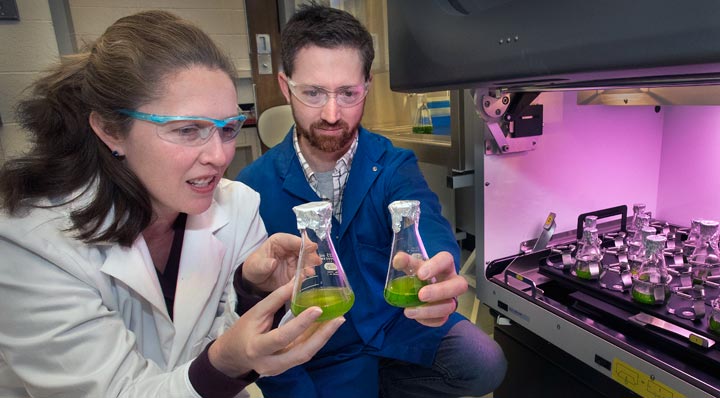National Synchrotron Light Source II User Profiles: Crysten Blaby
March 17, 2017
 enlarge
enlarge
Crysten and Ian Blaby are exploring the genes of algae to better understand—and potentially improve—plants' ability to harness energy.
Crysten Blaby is a member of the scientific staff in the Biology Department at the U.S. Department of Energy’s (DOE) Brookhaven National Laboratory. Many of the tools available at the National Synchrotron Light Source II (NSLS-II, a DOE Office of Science User Facility) will play a key role in her research: studying the genes that allow plants to harness energy and how those genes may be employed to enhance crops for bioenergy.
Please describe your experiment.
I am studying metal trafficking and compartmentalization in plants using a unicellular green alga as an experimental system. At NSLS-II, we have captured snapshots of metal ions (such as iron, zinc, copper and manganese) within the cell and collected data on where these nutrients go after they are imported into the cell.
From a nutritional perspective, these metal ions are precious commodities. They are essential catalytic cofactors for a multitude of enzymes in the cell, including the enzymes that are responsible for one of the most important processes on earth: photosynthesis. Plants have complex homeostatic mechanisms to ensure that the right metals at the right concentrations are in the right locations of the cell, which, in turn, ensures that its suite of metalloproteins (proteins that require a metal ion to function) are loaded with the correct metal ion.
Why is NSLS-II particularly suited to this research?
We are using the Submicron Resolution X-Ray Spectroscopy (SRX) beamline, where we will be able to push the boundaries of resolution and sensitivity in cellular metal-ion imaging. What is also unique about this particular beamline is that we can gather information about not only what metals are present, their concentrations, and their locations within the cell, but also data on their “chemical character,” including oxidation state. NSLS-II also has a suite of beamlines centered on addressing biological questions, such as discovering the structure of proteins, which I can use to further accelerate my research.
Tell us a bit about your background and current research interests.
My background is in microbial comparative genomics and genetics. As a graduate student I fell in love with transition-metal homeostasis and the diversity of such processes that are found in nature. Each genome is a roadmap to the niche-specific retention and loss of metal-dependent proteins and the pathways required to ensure adequate uptake and proper distribution of metals. Through an analysis of diverse genome sequences we can understand how organisms excel at acclimating to extremes of metal limitation and metal toxicity.
There is, however, a limit to how much understanding we can derive from comparative genomics. A second aspect of my research is experimental. Through comparative genomics and other functional genomics tools I arrive at hypotheses concerning metal homeostasis in the cell and then go to the bench, or in this case, to NSLS-II, and test those hypotheses.
With whom do you perform this work?
Our initial work at SRX was performed with Keith Jones, a senior scientist emeritus at Brookhaven who has extensive experience in imaging metals within plants, and the hard working team at SRX: beamline scientists Karen Chen-Wiegart and Garth Williams, and Juergen Thieme, the SRX beamline leader.
Brookhaven National Laboratory is supported by the Office of Science of the U.S. Department of Energy. The Office of Science is the single largest supporter of basic research in the physical sciences in the United States, and is working to address some of the most pressing challenges of our time. For more information, please visit science.energy.gov.
2017-12042 | INT/EXT | Newsroom









